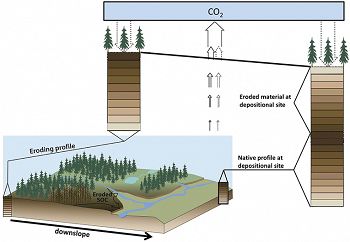Billings et al., 2019
Distinct contributions of eroding and depositional profiles to land-atmosphere CO2 exchange in two contrasting forests
Billings, Sharon A., Daniel de B. Richter, Susan E. Ziegler, Karen Prestegaard, and Anna M. Wade (2019)
Frontiers in Earth Science 7: article 36
-
Calhoun, INVESTIGATOR
-
Calhoun, INVESTIGATOR
-
Calhoun, GRAD STUDENT
Abstract
Schematic of a landscape experiencing erosion (upslope) and deposition (downslope), as conceptualized by the Soil Organic C Erosion Replacement and Oxidation-Deposition (SOrCERODe) model. Shades of brown at each depth depict variation in SOC concentrations with depth. In the eroding profile and native profile at the depositional site, SOC concentrations decline with depth. In eroded material deposited at depositional site, colors are inverted to represent topsoil layers with relatively high SOC concentrations being deposited prior to formerly deep layers. Note that the coloring does not reflect new SOC production at the depositional setting. At both eroding and depositional sites, SOC production (dashed downward-facing arrows) occurs concurrently with SOC oxidation (solid, upward-facing arrows) and CO2 production by autotrophs (dashed, upward-facing arrows). SOrCERODe allows the user to define the erosion rate, the deposition rate, and the degree to which SOC production and oxidation at each depth is influenced by erosion at the eroding site and by deposition at the depositional site.
Lateral movements of soil organic C (SOC) influence Earth's C budgets by transporting organic C across landscapes and by modifying soil-profile fluxes of CO2. We extended a previously presented model (Soil Organic C Erosion Replacement and Oxidation, SOrCERO) and present SOrCERODe, a model with which we can project how erosion and subsequent deposition of eroded material can modify biosphere-atmosphere CO2 fluxes in watersheds. The model permits the user to quantify the degree to which eroding and depositional profiles experience a change in SOC oxidation and production as formerly deep horizons become increasingly shallow, and as depositional profiles are buried. To investigate the relative importance of erosion rate, evolving SOC depth distributions, and mineralization reactivity on modeled soil C fluxes, we examine two forests exhibiting distinct depth distributions of SOC content and reactivity, hydrologic regimes and land use. Model projections suggest that, at decadal to centennial timescales: (1) the quantity of SOC moving across a landscape depends on erosion rate and the degree to which SOC production and oxidation at the eroding profile are modified as deeper horizons become shallower, and determines the degree to which depositional profile SOC fluxes are modified; (2) erosional setting C sink strength increases with erosion rate, with some sink effects reaching more than 40% of original profile SOC content after 100 y of a relatively high erosion rate (i.e., 1 mm y-1); (3) even large amounts of deposited SOC may not promote a large depositional profile C sink even with large gains in autochthonous SOC post-deposition if oxidation of buried SOC is not limited; and (4) when modeled depositional settings receive a disproportionately large amount of SOC, simulations of strong C sink scenarios mimic observations of modest preservation of buried SOC and large SOC gains in surficial horizons, suggesting that C sink scenarios have merit in these forests. Our analyses illuminate the importance of cross-landscape linkages between upland and depositional environments for watershed-scale biosphere-atmosphere C fluxes, and emphasize the need for accurate representations and observations of time-varying depth distributions of SOC reactivity across evolving watersheds if we seek accurate projections of ecosystem C balances.
Citation
Billings, Sharon A., Daniel de B. Richter, Susan E. Ziegler, Karen Prestegaard, and Anna M. Wade (2019): Distinct contributions of eroding and depositional profiles to land-atmosphere CO2 exchange in two contrasting forests. Frontiers in Earth Science 7: article 36. DOI: 10.3389/feart.2019.00036
 This Paper/Book acknowledges NSF CZO grant support.
This Paper/Book acknowledges NSF CZO grant support.
Explore Further




